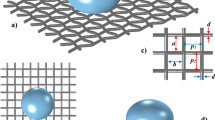Abstract
Analyses of the dynamic behavior of droplets are significant for a broad range of industrial applications. However, previous works have primarily studied the dynamic behavior on solid flat plates. Therefore, they could consider both the effect of geometric structure and energy simultaneously. In order to analyze the coupled-dynamic behavior of droplets, SMA membranes with microsphere arrays were used to apply the effects of both geometry and energy to droplet surfaces. The shape of the droplet changed harmonically with time during actuation. In the simulation, 50 and 200 Hz excitations related to the first and second droplet frequencies, respectively were used in order to investigate the coupled-behavior of the droplet. COMSOL Multiphasics™ was used to numerically analyze the dynamic behavior of droplets. The simulation results showed that the dynamic behavior of the water droplet was strongly affected by the natural frequency, and the interface and behavior were determined by both the mode shape and vibrating energy. As the actuation frequency increased, the energy equilibrium changed at the interface and occasionally broke. And then, the contact line on the actuated surface was changed to create new stable state.
Similar content being viewed by others
References
J. B. Lee, H. R. Gwon, S. H. Lee and M. Cho, Wetting transition characteristics on microstructured hydrophobic surfaces, Materials Transactions, 51 (9) (2010) 1709–1711.
M. Nosonovsky and B. Bhushan, Patterned nonadhesive surfaces: superhydrophobicity and wetting regime transitions, Langmuir, 24 (4) (2008) 1525–1533.
J. M. Oh, S. H. Ko and K. H. Kang, Shape oscillation of a drop in acelectrowetting, Langmuir, 24 (15) (2008) 8379–8386.
W. Lei, Z. H. Jia, J. C. He and T. M. Cai, Dynamic properties of vibrated drops on a superhydrophobic patterned surface, Applied Thermal Engineering, 62 (2) (2014) 507–512.
S. Daniel, M. K. Chaudhury and P. G. De Gennes, Vibrationactuated drop motion on surfaces for batch microfluidic processes, Langmuir, 21 (9) (2005) 4240–4248.
Y. S. Shin and H. C. Lim, Shape oscillation and detachment conditions for a droplet on a vibrating flat surface, The European Physical Journal E, 37 (8) (2014) 74.
W. Lei, Z. H. Jia, J. C. He, T. M. Cai and G. Wang, Vibration-induced Wenzel-Cassie wetting transition on microstructured hydrophobic surfaces, Applied Physics Letters, 104 (18) (2014) 181601.
T. D. Luong and N. T. Nguyen, Surface acoustic wave driven microfluidics-a review, Micro and Nanosystems, 2 (3) (2010) 217–225.
M. Kanungo, S. Mettu, K. Y. Law and S. Daniel, Effect of roughness geometry on wetting and dewetting of rough PDMS surfaces, Langmuir, 30 (25) (2014) 7358–7368.
A. Mall, P. R. Jelia, A. Agrawal, R. K. Singh and S. S. Joshi, Design of arrayed micro-Structures to get super-Hydrophobic surface for single droplet and bulk flow conditions, Proc. COMSOL Conf. (2009).
P. R. Jelia, A. Agrawal, R. K. Singh and S. S. Joshi, Design of textured surfaces for super-hydrophobicity, Sadhana, 42 (11) (2017) 1915–1927.
Y. Q. Zu and Y. Y. Yan, Single droplet on micro square-post patterned surfaces-theoretical model and numerical simulation, Scientific Reports, 6 (2016) 19281.
J. F. Gomez-Cortes, M. L. No, I. Ruiz-Larrea, T. Breczewski, A. Lopez-Echarri, C. A. Schuh and J. M. San Juan, Ultrahigh superelastic damping at the nano-scale: A robust phenomenon to improve smart MEMS devices, Acta Materialia, 166 (2019) 346–356.
S. F. Ou, K. K. Wang and Y. C. Hsu, Superhydrophobic NiTi shape memory alloy surfaces fabricated by anodization and surface mechanical attrition treatment, Applied Surface Science, 425 (2017) 594–602.
M. Kohl, H. Ossmer, M. Gueltig and C. Megnin, SMA foils for MEMS: From material properties to the engineering of micro-devices, Shape Memory and Superelasticity, 4 (1) (2018) 127–142.
A. Ishida, M. Sato, W. Yoshikawa and O. Tabata, Graphical design for thin-film SMA microactuators, Smart Materials and Structures, 16 (5) (2007) 1672.
K. Dong, X. Peng and Z. L. Wang, Fiber/fabric - based piezoelectric and triboelectric nanogenerators for flexible/stretchable and wearable electronics and artificial intelligence, Advanced Materials (2019).
R. H. Temperton, Resonant vibrations of microlitre liquid drops, Doctoral Dissertation, University of Nottingham (2013).
J. C. Miers and W. Zhou, Droplet formation at megahertz frequency, AlChE Journal, 63 (6) (2017) 2367–2377.
COMSOL, COMSOL User Manual - CFD Module - Level Set Method.
R. N. Govardhan, G. S. Srinivas, A. Asthana and M. S. Bobji, Time dependence of effective slip on textured hydrophobic surfaces, Physics of Fluids, 21 (5) (2009) 052001.
J. M. Oh, S. H. Ko and K. H. Kang, Shape oscillation of a drop in ac electrowetting, Langmuir, 24 (15) (2008) 8379–8386.
Acknowledgments
This work was supported by the National Research Foundation of Korea (NRF) grant funded by the Korea government. (MSIT) (2018R1A2B6006891).
Author information
Authors and Affiliations
Corresponding author
Additional information
Recommended by Editor No-cheol Park
Dong-Su Park is majoring in mechanical engineering at Gachon University. He’s studying for master’s degree. Especially he is specialized at vibration.
Kyoung-Su Park was born in Seoul, Korea, in 1976. He received the B.E. degree in electrical-mechanical engineering from the Yonsei University, Seoul, Korea, in 2000, and the master and Ph.D. degrees in mechanical engineering from the Yonsei University, Seoul, Korea in 2002 and 2006, respectively. In 2006, he joined the Samsung Electronics Corp. and he has worked for about three years. Since September 2008, he has been a Research Professor with the School of Mechanical Engineering at the Yonsei University. And he has become an Associate Professor in mechanical engineering at Gachon University since 2019. His current research interests include the vibration and control issues for cable-driven parallel robot, vibration issues for ultra-high speed maglev and nano-level vibration issues. He has served as executive member for about 10 years in ASME-ISPS (Information Storage and Processing System) and he became a Chair of ASME-ISPS Division from July 2016 to August 2017.
Rights and permissions
About this article
Cite this article
Park, DS., Park, KS. Numerical analyses of the coupled-dynamic behavior of droplets on a vibrating membrane with a microsphere array at a three-phase interface. J Mech Sci Technol 34, 659–666 (2020). https://doi.org/10.1007/s12206-020-0111-x
Received:
Revised:
Accepted:
Published:
Issue Date:
DOI: https://doi.org/10.1007/s12206-020-0111-x



